Nokia Lumia 830 Review
by Brett Howse on November 25, 2014 8:00 AM EST- Posted in
- Smartphones
- Microsoft
- Lumia
Battery Life
Battery life, like the display, is one of the most important aspects to any smartphone. The Lumia 830 comes with a removable BV-L4A battery, which is a 2200 mAh, with 3.8-volt chemistry. This gives us a battery with 7.04 Wh of capacity. This is quite a bit smaller than the Lumia 930’s 9.20 Wh battery, but it also powers a lower resolution display which is much less power hungry than the Lumia 930’s OLED unit.
As with the performance comparisons, the graphs below are a subset of all of our devices which I chose to compare the Lumia 830 against other phones which are in the same market. Someone considering the Note 4 is likely not cross shopping with a Lumia 830 for instance. If there is a device that we’ve tested, you can use our online benchmark comparison tool Bench to compare any devices we have tested.
To compare battery life, we set all devices to the same brightness level (200 nits) in order to not penalize displays which have a higher maximum brightness. We then put them through several tests a couple of times each to ensure accurate results.
One note is a change to how I am testing Windows Phone battery life. Historically I have run a battery life test, and then done it again with Battery Saver enabled. Battery Saver on Windows Phone stops all background apps from syncing while it is running, and things like email will not work with push support. On our Android reviews, we already disable background syncing while doing battery life testing to ensure consistent results, so starting with the Lumia 830 I will be only showing battery life with Battery Saver enabled. Feel free to give me your feedback in the comments below, but this should give a more accurate result and a baseline we can work off of.
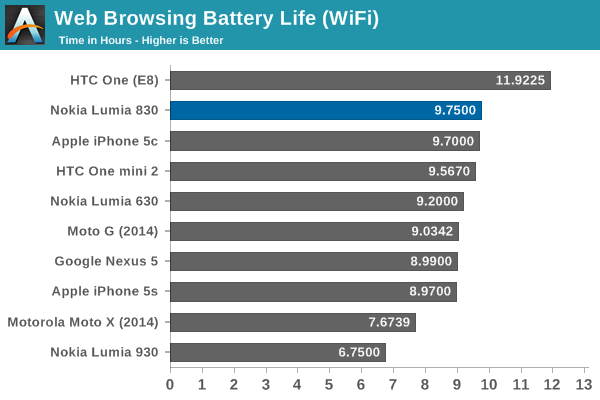
Our first test is web browsing over Wi-Fi. The Lumia 830 is very good here. When doing the Lumia 930 review, that device would actually get warm to the touch just from displaying a white background, but the Lumia 830 does not suffer any of those issues with its LCD display. The result of almost ten hours of screen on time is very good, and should allow almost anyone to easily get through a day of use before needing to charge. Please note that I have adjusted the Lumia 630 and 930 results in the above graph to show them with Battery Saver enabled so that this is an apples-to-apples comparison.
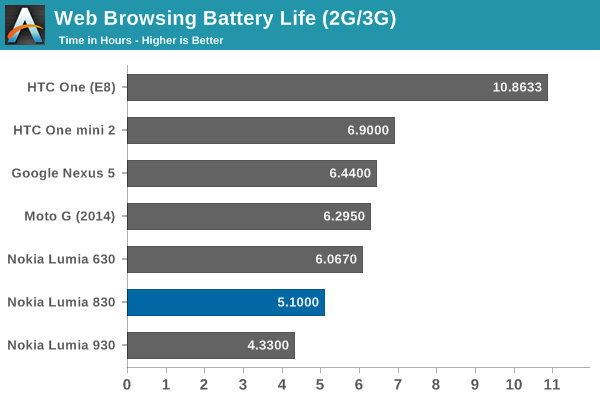
Although the Lumia 830 does support LTE, it will of course fall back to HSPA if the LTE signal is not strong enough. HSPA battery life is not fantastic. I was unable to test LTE battery life on this phone due to the model shipped to me.
In addition to the web browsing test, we have also started to utilize the Basemark OS II Battery Life test.
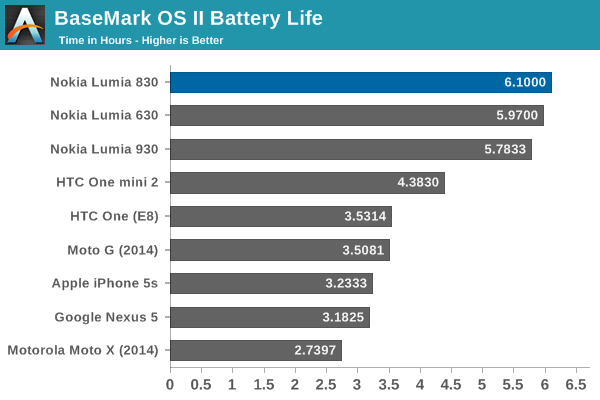
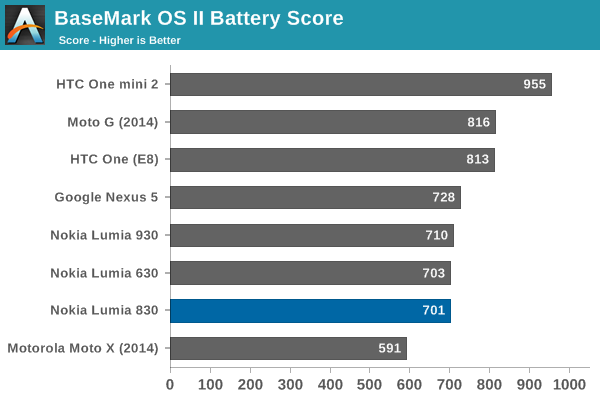
The Lumia 830 does well in the battery life for Basemark, but that does not tell the entire story. The overall score is calculated based on the average battery life loss per minute, as well as the standard deviation and CPU usage during the test. Windows Phone is at a disadvantage here somewhat due to the nature of the benchmark. As it cannot get CPU usage information from the OS, it does not factor it into the final score. While the benchmark was running, the CPU usage was only at 10%.
Charge Time
The speed at which a device can charge can be fairly important if you travel a lot and need to top up. Generally devices charge quickly at the beginning and then ease back over time until they hit 100%, so this is more than just about the overall charge time to 100%. I will now include a graph with the charge percentage over time.

The Lumia 830 comes with a 1.5 Amp micro USB charger, which can fill the battery in about 2:40. This is a higher amperage charger than is included with a device such as the Lumia 630, and it makes a difference. The Snapdragon 400 SoC does support quick charge, at up to 9 volts at 1.5 amps, and Windows Phone does support this.
The Lumia 830 charge rate is fairly consistent all the way up until 90% where it starts to taper off.
For those that hate plugging in their phones, the Lumia 830 also supports Qi wireless charging out of the box.


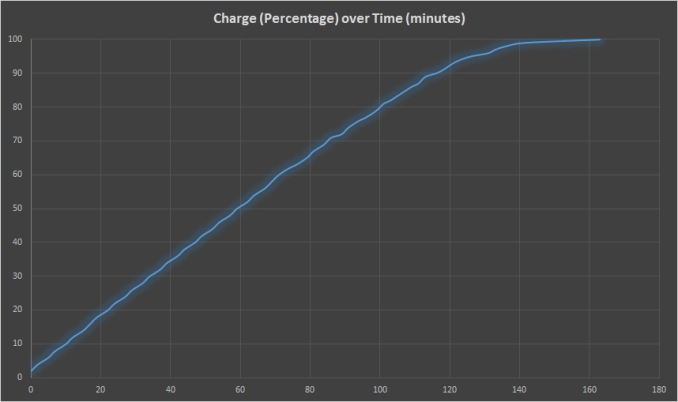
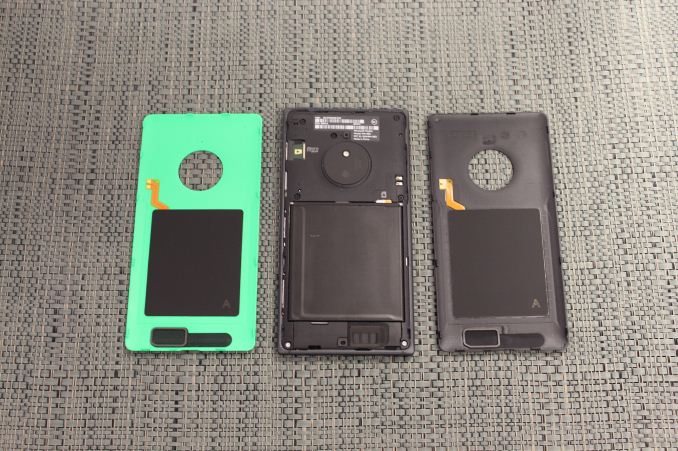








98 Comments
View All Comments
Daniel Egger - Tuesday, November 25, 2014 - link
Well, I called it months ago that this phone is in many ways inferior to its predecessor. Would have been nice to include the benchmarks for the 820 but I already have a good idea on how that would compare.@Microsoft, sign me up for the next phone with a <5" OLED display that is run by something else than those measly entry level Cortex A7s, no problem if it's "just" a dual-core...
BedfordTim - Tuesday, November 25, 2014 - link
Add me to the list too. Changing to a smaller phone was a revelation and I don't want to go back to carting a tablet around all the time.LittleB69 - Tuesday, November 25, 2014 - link
Been waiting for a new flagship model with Glance support from Microsoft. It has not arrived yet so I am sticking with my 920. Actually I have been thinking about going back to Android. Moved from Apple to HTC (Android) and from Android to Windows Phone. Was pretty happy as an Android user. After being without my WP for less than a week and using a S4.. I am staying on WP for sure :-)Gunbuster - Tuesday, November 25, 2014 - link
I'm in pretty much the same boat. Waiting for an upper end SOC, Qi charging, Glance, and Hey Cortana, and a good camera. How hard is it to just check all the boxes.P.S. they need to figure out cross carrier WiFi calling and then just sell it unlocked through the Microsoft store supporting ATT and T-Mobile.
tolgerias - Tuesday, November 25, 2014 - link
As the owner of a Lumia 920 I am very interested in this phone. I know it's not a flagship, but I love the design and I prefer the 5" screen even though it is only 720p. If I could find this phone for $300 off contract I would buy it instantly, so I'll keep an eye out for it. There are a few things that would be an upgrade for me:1. 5" vs 4.5" screen
2. Sensor Core
3. Thinner and lighter design
4. Newer SoC
Last year I bought an iPhone 5s on my contract renewal, but even though I like iOS 8, I find myself going back to my 920 most of the time. I just love the amount of information WP 8.1 provides me at a glance. Live tiles, glance screen, and wireless charging are absolutely brilliant and always miss them when I am on a phone that doesn't have them.
So I'll stick with my 920 for now and will either jump on an 830 if the price is right, or I'll wait for the next true flagship to appear in 2015.
MarcSP - Tuesday, November 25, 2014 - link
I know Anandtech is known for its extensive benchmarking, but I think the performance section should include also a subjective assessment of the performance during "normal" use. Just looking at the numbers someone could understand that the device lags badly or even that the user experience must be quite frustrating. None of the reviews on other sites said so, on the contrary, they praised the general fluidity of the system except in a few high end games or very specific CPU/GPU intensive apps.cheshirster - Friday, November 28, 2014 - link
+830Brett Howse - Friday, November 28, 2014 - link
Hi. I wanted to address this comment because it's important.I did mention this in the performance section: "Microsoft has done a great job with the UI and animations of Windows Phone to make them fast and without the jitter of some platforms, even on low end hardware. But that does not help in-app performance, nor the app loading times."
Windows Phone has been fluid since practically day 1. They really nailed that part. But it is all of the other areas where the performance is a let down. You just see a lot more "Resuming..." screens on a device like the 830 than a much more powerful system like the 930. Opening apps can take far longer.
Performance is important even if the UI is smooth. There seems to be a common misconception that due to the OS being well designed for a smooth UI, the performance is not as important but really that's never the case.
I can give the Lumia 630 a pass by having Snapdragon 400 - that phone is now selling outright for under $100 in some places. I get it. But a device like the Lumia 830 has that same SoC yet costs 3-4 times more money than the Lumia 630. It needs to have something better. I mentioned Snapdragon 600 because the quad-core Krait is quite a bit more powerful even if it likely isn't the perfect choice due to no integrated baseband, but the OnePlus One comes with Snapdragon 801 for $299. For the price range the 830 came in at, it needs to be quicker.
So yes, it's fluid when using the OS, but once you get past the OS and launch an app, it's not as good as it needs to be for this price range.
cheshirster - Friday, November 28, 2014 - link
Please don't bring Cyanogen phones in compartion.830 is obviously not for extreme spec and adrenaline seekers.
Do you have any tests on hands to post FAR longer times?
There were no such evidences between last gen 520 and 920.
S600 is not just "is'n perfect", it is largely outdated power-hungry SoC with no Sensor Core support (which you completely missed in the review).
Basically even you can not provide the name of hypothetical "better soc for 830" so I don't understand where all those complains are coming from.
Brett Howse - Friday, November 28, 2014 - link
Snapdragon 800. There you go.